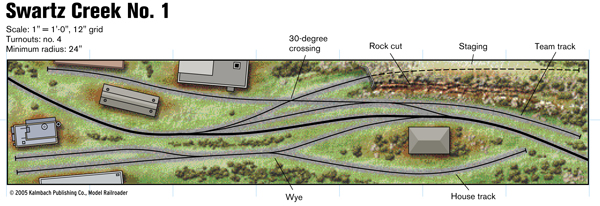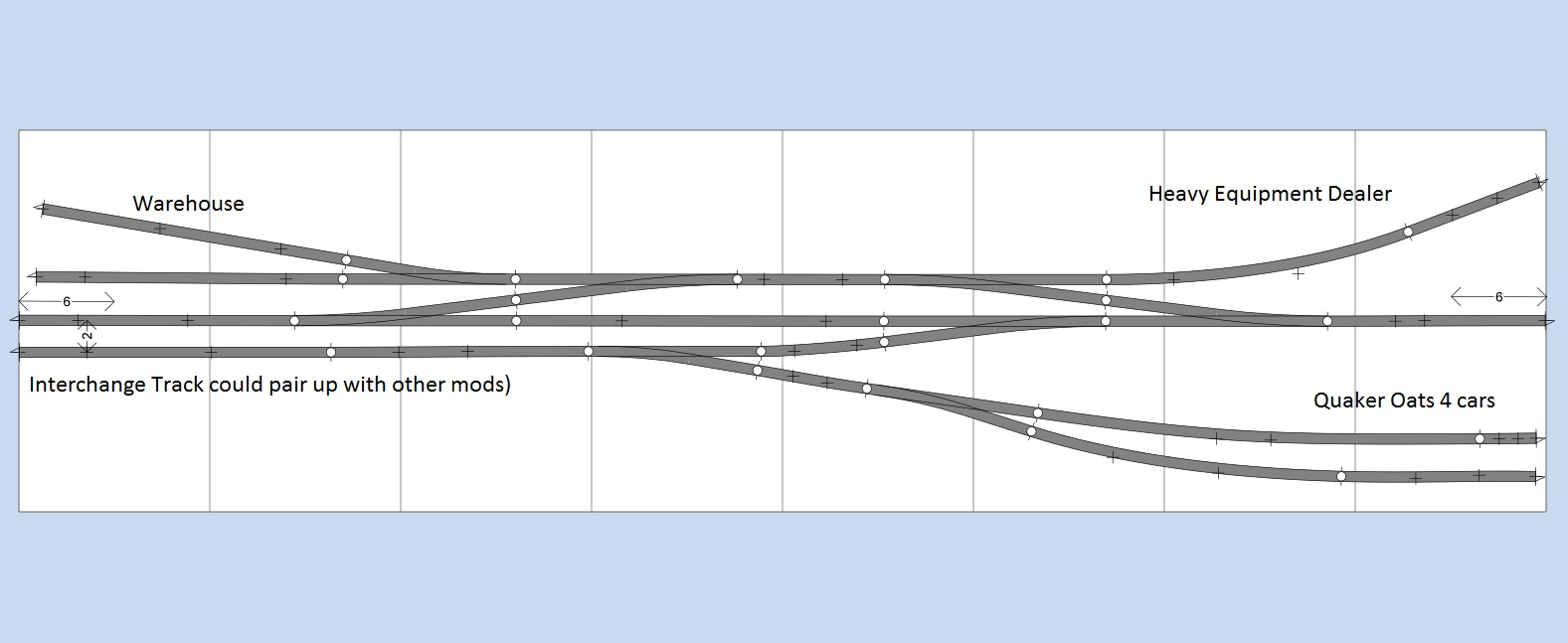Hi,
I am planning to build a 2' x 8" ho shelf layout (dc) something along the lines of either design below -

or

I have Siever's benchwork and Atlas code 100 track that I bought 30 years ago and now have time to make a layout. This will be my first layout and I wanted to post for advice -
- I have good supply of Atlas code 100 track with 3 Atlas snap switches and 2 Atlas #4 custom line turnouts and 1 Atlas custom line wye turnout. I am planning to buy Peco code 100 #6 turnouts and not use any of the Atlas turnouts, except perhaps the wye. I have read the snap switches are prone to problems, that #6 turnouts would be a better choice than #4 and have read good things about Peco's turnouts. The Unifrogs don't come in code 100 so thinking the main decision I think I have left is whether to get the Insulfrogs or ElectroFrogs. I have read that the Electrofrogs have the advantage for low speed operation so leaning to go with them. The Electrofrogs require more wiring than the Insulfrogs but doesn't look like much extra work. Any advice about turnouts in general or the Electrofrog vs Insulfrogs will be greatly appreciated.
- Will it make any sense to divide this small layout into separate electrical blocks? I am going to be the only one operating the layout. Would 2 locomotives be used on such a layout?
- I am planning to install hand thrown ground controls (Caboose Industries CAB5218S) to start with and maybe add Tortoise switch machines later. If the Siever's benchwork will interfere with the location of any of the Torsoise switch machines would it make more sense to move the location of the turnout or leave as planned and do a work around for the Tortoise switch machine?
- I am building the layout at an offsite location and will need to transport it one time. I have a minivan that can haul the 2' x 8' layout in one piece if turned on it's side and can delay putting the final touches on until after transport so thinking it isn't worth the extra work to divide into modular 2' x 4' sections that can assembled/disassembled.
-Some of my track looks a bit dirty? and wanted to see if alcohol is good cleaner? Any issue using the Walther's Bright Boy track cleaner?
- I plan to use Kadee couplers and any advice about the best decoupling methods (magnetic vs magnetic delayed, under track vs between rails, hand magnetic tool vs hand pick, magnetic vs electric) will also be appreciated. I would like to start with a simple method such as hand magnetic tool, then add magnet or electro-magnet later.
- Which of the 2 track plans look better? Is there a different direction I should consider for a 2' x 8' layout?
Thanks in advance for any advice!
Dave
I am planning to build a 2' x 8" ho shelf layout (dc) something along the lines of either design below -
or
I have Siever's benchwork and Atlas code 100 track that I bought 30 years ago and now have time to make a layout. This will be my first layout and I wanted to post for advice -
- I have good supply of Atlas code 100 track with 3 Atlas snap switches and 2 Atlas #4 custom line turnouts and 1 Atlas custom line wye turnout. I am planning to buy Peco code 100 #6 turnouts and not use any of the Atlas turnouts, except perhaps the wye. I have read the snap switches are prone to problems, that #6 turnouts would be a better choice than #4 and have read good things about Peco's turnouts. The Unifrogs don't come in code 100 so thinking the main decision I think I have left is whether to get the Insulfrogs or ElectroFrogs. I have read that the Electrofrogs have the advantage for low speed operation so leaning to go with them. The Electrofrogs require more wiring than the Insulfrogs but doesn't look like much extra work. Any advice about turnouts in general or the Electrofrog vs Insulfrogs will be greatly appreciated.
- Will it make any sense to divide this small layout into separate electrical blocks? I am going to be the only one operating the layout. Would 2 locomotives be used on such a layout?
- I am planning to install hand thrown ground controls (Caboose Industries CAB5218S) to start with and maybe add Tortoise switch machines later. If the Siever's benchwork will interfere with the location of any of the Torsoise switch machines would it make more sense to move the location of the turnout or leave as planned and do a work around for the Tortoise switch machine?
- I am building the layout at an offsite location and will need to transport it one time. I have a minivan that can haul the 2' x 8' layout in one piece if turned on it's side and can delay putting the final touches on until after transport so thinking it isn't worth the extra work to divide into modular 2' x 4' sections that can assembled/disassembled.
-Some of my track looks a bit dirty? and wanted to see if alcohol is good cleaner? Any issue using the Walther's Bright Boy track cleaner?
- I plan to use Kadee couplers and any advice about the best decoupling methods (magnetic vs magnetic delayed, under track vs between rails, hand magnetic tool vs hand pick, magnetic vs electric) will also be appreciated. I would like to start with a simple method such as hand magnetic tool, then add magnet or electro-magnet later.
- Which of the 2 track plans look better? Is there a different direction I should consider for a 2' x 8' layout?
Thanks in advance for any advice!
Dave

